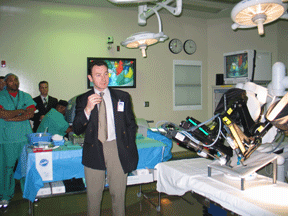 |
Dmitry Oleynikov, M.D., talks about the da Vinci robotic system in one of the new operating room suites. |
The center features 27 new state-of-the-art surgical suites with each room measuring approximately 625 square feet.
“These operating rooms allow us to bring the patients into the 22nd century with integrated video, digital information systems and the ability to communicate with the Internet and other physicians around the world,” said Dmitry Oleynikov, M.D., director of education and training for the minimally invasive and computer-assisted surgery initiative at UNMC.
Because each operating room is outfitted with minimally invasive surgical technology, the staff no longer needs to move heavy equipment from room to room or hook-up complicated audio-visual equipment. All lighting and temperature controls will be at the staff’s fingertips – not across the room.
“This will be the biggest install of technically advanced minimally invasive suites in the country,” said Mark Emodi, manager of Perioperative Services at The Nebraska Medical Center.
Approximately 17,200 surgeries are performed each year at The Nebraska Medical Center.
“Minimally invasive surgery and robotic surgery has become the staple of The Nebraska Medical Center,” Dr. Oleynikov said. “The new operating rooms are going to allow us to perform these tasks with a great deal of precision and a great deal of safety for the patients.”
The operating rooms employ 113 registered nurses and 37 surgical technicians with an average length of service of more than eight years.
“We are so excited about the new surgical suites,” said nurse Missy O’Brien, general surgery service coordinator. “We’ll have bigger rooms and consistent technology from OR to OR, which means rather than making sure equipment is hooked up, we can give the patient, surgeon and staff extra focus.”
The new Sterile Processing area will support 5,000 surgical instrument sets – 250 sets are used each day. The operating rooms, which are designed especially for complicated, minimally invasive procedures, feature green lighting to help surgeons better visualize monitor images and intensity.
“It will allow them to perform complicated surgeries with greater ease and more efficiency. Ultimately, that translates into benefits to patients — greater safety and greater convenience of use,” Dr. Oleynikov said.
The operating rooms will open in three stages, with the first 15 rooms coming on line in January. Five more will follow in the fall of 2006 and seven more will open to patients in approximately two years. Surgery will continue to be performed in the existing University Tower operating rooms, as well. The Clarkson Tower operating room and University Surgical Center will close in January.